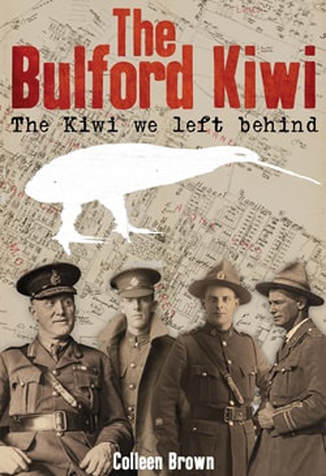
by Colleen Brown
This is the story of an emblem on a hillside in southern England, in the shape of a large kiwi, that was created in 1919 by New Zealand servicemen waiting to return home.
Colleen Brown has researched both the plight of the waiting Kiwi servicemen, and their symbolic kiwi on Beacon Hill overlooking the Salisbury plains. Though the link becomes clear as the book unfolds, it takes a while to get to the creation of the iconic kiwi carved in chalk, and then in the second part we read about its resurrection.
As Brown states, this is a social history, albeit one focussed on servicemen, not a military history. The predicament facing the soldiers returning from the Western Front after hostilities ceased in 1918 is not well known, and most became marooned in the Sling training camp for an indefinite period while ships were found to return them home. Boredom and then disease began to eat away at morale, as well as news of labour unrest on the English docks, and scheduled sailings being postponed. Into the spring of 1919 and frustrations boiled over, the result was a ‘riot’ by the lower ranks. Only a few soldiers were punished but some positive new activity had to be found.
The idea for the symbolic kiwi to be created appears to be that of the departing New Zealand commander Brigadier-General Stewart. Although the genesis of the kiwi is somewhat sketchy, the drawing of the native bird was by Percy Blenkarne, a member of the army education unit originally from Auckland. The translation of the drawing to sloping hill site was assisted by Victor Low, a Chinese New Zealander from Dunedin who had been an engineer in the tunnelling company, famous for active service at Arras, France. The completion of the task was overseen by Harry Clark, a veteran of Gallipoli, who had to try to find 250 men each day to construct the kiwi. Eventually, mainly due to the exertions of Canterbury contingent, it was completed.
The author sticks to the specifics of the story, and closely to the archival sources she has uncovered. After the kiwi was finished and the New Zealanders returned home the question became who would look after the huge emblem. Initially this was undertaken by an Australian shoe polish company, known as Kiwi Polish, as a mark of respect to the servicemen. The emblem was then left to grow over during World War 2, and then there were attempts to rebuild it after the war, including those of the local scout group. The New Zealand government failed to co-ordinate and pay for the local maintenance, so by 1980 some individual British soldiers came to the rescue.
This is quite a charming story and heart-warming, but also somewhat brief. It is in a way too specific and lacks some broader context. In particular, there is no detailed map of the location of the training camps, other than a very general illustration of the south of England. Beacon Hill and the Salisbury plain are in the county of Wiltshire, but this is never made clear.
And there is only a brief mention of the other symbols that were created by servicemen at the Australian training camps nearby. For instance, a recent episode of the TV programme Escape to the Country, based in Wiltshire, identified another symbol near Codford which was described as an ‘Anzac badge’. It would have been good to have more of an overview of all the symbols created in the Wiltshire hills by servicemen from down under, to provide more context for the Bulford Kiwi.
But Colleen Brown has done a great service by bringing the story to light, and the publishers have also provided a very sympathetic design for the book.
Author: Colleen Brown
Publisher: Bateman Publishing
ISBN: 978-186953-984-9
RRP: $39.99
Available: bookshops

 RSS Feed
RSS Feed
